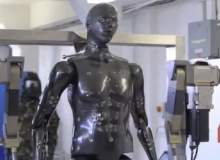

Discover B2B Marketing That Performs
Combine business intelligence and editorial excellence to reach engaged professionals across 36 leading media platforms.
Railgun testing
This week, the US Navy outlined plans to deploy and test a prototype electromagnetic railgun on-board a ship in 2016. On the back of this announcement, BAE Systems has released more footage of its railgun testing.
While the explosive launch and the projectile in flight has been shown before, this time BAE Systems has shared the destructive power it can unleash on a target. Using no explosives, just sheer kinetic force, it obliterates an armoured vehicle and tears through layer after layer of steel shipping crates. The US Navy hopes it will do the same to enemy vessels.
Porton Man
The British MoD’s Dstl research arm has introduced a realistic humanoid robot named Porton Man after the Dstl’s Porton Down headquarters.

US Tariffs are shifting - will you react or anticipate?
Don’t let policy changes catch you off guard. Stay proactive with real-time data and expert analysis.
By GlobalDataThe £1.1m robot was built by i-bodi Technology using Formula 1 materials, and can walk, march, run, sit, kneel and even position his arms akin to an infantryman holding a weapon.
Porton Man has more than 100 sensors over its body to test protective equipment for soldiers exposed to chemical and biological agents letting scientists carry out real-time analysis.
Increasingly lifelike robots such as Porton Man and Boston Dynamics’ PETMAN are significantly improving methods of realistically testing equipment to protect soldiers.
Seawater fuel
The military is a massive consumer of fossil fuel, and with prices rising and supplies dwindling, researchers are always looking for alternatives. The US Naval Research Laboratory, or NRL, has demonstrated new proof-of-concept technology that could produce jet fuel from seawater on a large scale.
The NRL’s method extracts carbon dioxide and produces hydrogen from seawater then recombines them to produce a liquid hydrocarbon fuel. NRL scientists have used the resulting fuel to power the internal combustion engine on a model aircraft.
According to the NRL, within ten years a commercial version of this process could produce jet fuel for less than $6 a gallon.



